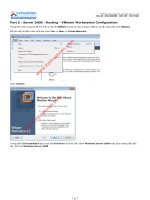ISO 264322:2008 Digital source processing — Part 2: Digital cinema (Dcinema) low frequency effects (LFE) channel audio characteristics
Bạn đang xem bản rút gọn của tài liệu. Xem và tải ngay bản đầy đủ của tài liệu tại đây (213.06 KB, 8 trang )
INTERNATIONAL ISO
STANDARD 26432-2
First edition
2008-07-15
Digital source processing —
Part 2:
Digital cinema (D-cinema) low frequency
effects (LFE) channel audio
characteristics
Procédé de source numérique —
Partie 2: Caractéristiques sonores de chne des effets basse
fréquence du cinéma D
Reference number
ISO 26432-2:2008(E)
© ISO 2008
ISO 26432-2:2008(E)
PDF disclaimer
This PDF file may contain embedded typefaces. In accordance with Adobe's licensing policy, this file may be printed or viewed but
shall not be edited unless the typefaces which are embedded are licensed to and installed on the computer performing the editing. In
downloading this file, parties accept therein the responsibility of not infringing Adobe's licensing policy. The ISO Central Secretariat
accepts no liability in this area.
Adobe is a trademark of Adobe Systems Incorporated.
Details of the software products used to create this PDF file can be found in the General Info relative to the file; the PDF-creation
parameters were optimized for printing. Every care has been taken to ensure that the file is suitable for use by ISO member bodies. In
the unlikely event that a problem relating to it is found, please inform the Central Secretariat at the address given below.
COPYRIGHT PROTECTED DOCUMENT
© ISO 2008
All rights reserved. Unless otherwise specified, no part of this publication may be reproduced or utilized in any form or by any means,
electronic or mechanical, including photocopying and microfilm, without permission in writing from either ISO at the address below or
ISO's member body in the country of the requester.
ISO copyright office
Case postale 56 • CH-1211 Geneva 20
Tel. + 41 22 749 01 11
Fax + 41 22 749 09 47
Web www.iso.org
Published in Switzerland
ii © ISO 2008 – All rights reserved
ISO 26432-2:2008(E)
Foreword
ISO (the International Organization for Standardization) is a worldwide federation of national standards bodies
(ISO member bodies). The work of preparing International Standards is normally carried out through ISO
technical committees. Each member body interested in a subject for which a technical committee has been
established has the right to be represented on that committee. International organizations, governmental and
non-governmental, in liaison with ISO, also take part in the work. ISO collaborates closely with the
International Electrotechnical Commission (IEC) on all matters of electrotechnical standardization.
International Standards are drafted in accordance with the rules given in the ISO/IEC Directives, Part 2.
The main task of technical committees is to prepare International Standards. Draft International Standards
adopted by the technical committees are circulated to the member bodies for voting. Publication as an
International Standard requires approval by at least 75 % of the member bodies casting a vote.
Attention is drawn to the possibility that some of the elements of this document may be the subject of patent
rights. ISO shall not be held responsible for identifying any or all such patent rights.
ISO 26432-2 was prepared by the Society of Motion Picture and Television Engineers (as
SMPTE EG 432-2-2006) and was adopted, under a special “fast-track procedure”, by Technical Committee
ISO/TC 36, Cinematography, in parallel with its approval by the ISO member bodies.
ISO 26432 consists of the following parts, under the general title Digital source processing:
⎯ Part 2: Digital cinema (D-cinema) low frequency effects (LFE) channel audio characteristics
© ISO 2008 – All rights reserved iii
ISO 26432-2:2008(E)
EG 432-2-2006
SMPTE ENGINEERING GUIDELINE
Digital Source Processing —
D-Cinema Low Frequency Effects (LFE)
Channel Audio Characteristics
Page 1 of 3 pages
Table of Contents
Foreword ......................................................................................................................................................... 1
Introduction ..................................................................................................................................................... 1
1 Scope .......................................................................................................................................................... 2
2 Parameters.................................................................................................................................................. 2
Annex A Bibliography.................................................................................................................................... 3
Foreword
SMPTE (the Society of Motion Picture and Television Engineers) is an internationally-recognized standards
developing organization. Headquartered and incorporated in the United States of America, SMPTE has
members in over 80 countries on six continents. SMPTE’s Engineering Documents, including Standards,
Recommended Practices and Engineering Guidelines, are prepared by SMPTE’s Technology Committees.
Participation in these Committees is open to all with a bona fide interest in their work. SMPTE cooperates
closely with other standards-developing organizations, including ISO, IEC and ITU.
SMPTE Engineering Documents are drafted in accordance with the rules given in Part XIII of its
Administrative Practices.
SMPTE Engineering Guideline EG 432-2 was prepared by Technology Committee DC28.
Introduction
For interoperability of digital cinema equipment used to deliver LFE channel audio to the playback equipment
in D-Cinema environments, standardized electrical frequency response for the playback LFE channel is
needed. The necessary characteristics are turnover frequency, slope and deviation.
Copyright © 2007 by THE SOCIETY OF Approved December 29, 2006
MOTION PICTURE AND TELEVISION ENGINEERS
3 Barker Avenue, White Plains, NY 10601 1
(914) 761-1100
© ISO 2008 – All rights reserved
ISO 26432-2:2008(E)
EG 432-2-2006
1 Scope
This guideline addresses interoperability of equipment from the standpoint of the frequency response of filters
used in the playback or monitor path in the theater LFE channel for digital cinema. This response curve will
create standardization of these filters without specifying their design.
2 Parameters
2.1 Turnover Frequency
The turnover frequency is defined as the point at which the response of the filter is at –3 dB from the
passband reference. The LFE channel shall have a turnover frequency of 125 Hz.
2.2 Filter Slope
The filter slope of the LFE Channel shall be as per the Reference Filter Response Table (section 2.4) from
the turnover frequency of 125 Hz.
2.3 Deviation
Deviation within the passband shall be ± 1 dB and the deviation of the turnover frequency (– 3 dB point) shall
be ± 5 Hz.
2.4 Reference Filter Frequency Response Table
Frequency Attenuation
Hz dB
25Hz 0dB
31.5Hz 0dB
40Hz 0dB
50Hz 0dB
63Hz 0dB
80Hz 0dB
100Hz 0dB
125Hz -3dB
160Hz -45dB
200Hz -102dB
Page 2 of 3 pages © ISO 2008 – All rights reserved
2
ISO 26432-2:2008(E)
EG 432-2-2006
Annex A (Informative)
Bibliography
SMPTE 202M-1998, Motion-Pictures — Dubbing Theaters, Review Rooms and Indoor Theaters — B-Chain
Electroacoustic Response
SMPTE RP 200-2002, Relative and Absolute Sound Pressure Levels for Motion-Picture Multichannel Sound
Systems — Applicable for Analog Photographic Film Audio, Digital Photographic Film Audio and D-Cinema
© ISO 2008 – All rights reserved Page 3 of 3 pages
3
ISO 26432-2:2008(E)
ICS 37.060.99
Price based on 2 pages
© ISO 2008 – All rights reserved









